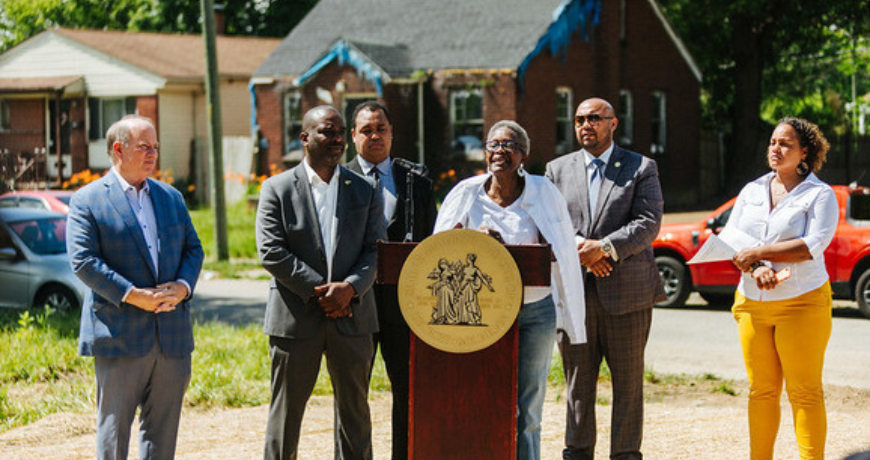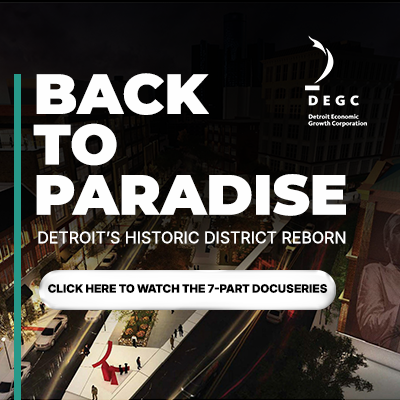Residents in three Detroit neighborhoods who have lived for decades adjacent to some of Detroit’s worst blight received a powerful message this week from Mayor Mike Duggan: You have not been forgotten. Mayor Duggan joined with residents of the Gratiot/Findlay, Van Dyke/Lynch, and State Fair communities to announce their selection as Detroit’s first “solar neighborhoods.” These neighborhoods will host the initial phase of Detroit’s Solar Neighborhood Project, repurposing blighted vacant land for solar energy and aiming to make Detroit a national leader in fighting climate change.
The Solar Neighborhood Project will transform 103.9 acres of land into solar arrays, bringing Detroit halfway to its goal of creating approximately 200 acres of solar arrays. This project is part of a broader plan to generate enough clean energy to offset the electricity used by all 127 city municipal buildings, which currently consume 33 megawatts of electricity from traditional sources. By building 200 acres of solar arrays, Detroit will generate 33 megawatts of renewable energy, addressing both environmental and infrastructural issues.
In June 2023, Mayor Duggan called on neighborhood groups to address blight by constructing solar fields in the most neglected areas, promising community benefits in the form of home improvements. After a year of extensive community engagement, the process narrowed to eight finalists with overwhelming community support. The Mayor submitted proposals to the City Council to proceed with the solar fields in the first three neighborhoods, starting the process of land acquisition, community benefits, and solar field installation.
All Phase 1 owners of owner-occupied homes have entered into agreements for voluntary buy-outs by the City. Out of the 104 acres in Phase 1, only 21 owner-occupied homes were identified, and all homeowners have signed option contracts for an agreed-upon price. Renters will receive relocation costs and 18 months of free rent in their new homes. Landlords and vacant landowners will be paid fair market value for their property under Michigan condemnation law.
State Fair resident and homeowner Gloria McHenry expressed her excitement, stating, “I like that we are trying to get Detroit clean. For so many years, it has been a dumping ground in this area and an area that everyone had forgotten about. I thought it would never happen, but I really like the idea of the solar to come to the State Fair with that investment it will bring our beautiful City of Detroit back. It’s been too long.”
In addition to repurposing blighted land, the project includes home improvement community benefits for 159 adjoining homeowners. These homeowners, who helped define the boundaries of the community benefits zones, will receive home improvements ranging from $15,000 to $25,000. Eligible upgrades include energy-efficient windows, roofs, residential solar panels, appliances, home insulation, furnaces, hot water heaters, smart thermostats, lighting, and battery backup systems.
John Mcannich, a resident, commented, “The solar project is a great opportunity for the revitalization and stabilization of Penrose, combining community benefit investment into homes along with the establishment of home values while occupying desolate areas that attract dumping and other activities.”
The City selected two developers for the project: Lightstar Renewables and DTE Electric Company. Lightstar Renewables will develop 63 acres of solar fields in the Gratiot/Findlay and State Fair neighborhoods in Phase 1. DTE Electric Company will develop a 40-acre solar field in the Van Dyke/Lynch neighborhood. In Phase 2, it is expected that DTE will be awarded two additional neighborhoods, and Lightstar one, ensuring an even distribution of the project.
Non-profit organizations have played a crucial role as advocates throughout the process and will continue to support neighborhood groups. The City of Detroit will maintain ownership of the land and lease it to the developers. City Councilmember Scott Benson expressed excitement about the project, thanking everyone involved in the community engagement process and emphasizing the goal of 100% renewable energy offset for municipal buildings.
Funding for the project comes from tax credits provided by the Inflation Reduction Act of 2022, which reduced the costs of large-scale solar projects by 30%. Capital costs will be paid by the City of Detroit’s Utility Conversion Fund, a long-standing fund legally required to be used for energy conversion. The fund will cover the $14 million upfront costs for acquiring and clearing the land, with no new appropriation needed.
Net operating costs are projected to increase by $1.1 million per year. Currently, the City spends nearly $2.4 million annually within the boundaries of the three blighted solar field zones on illegal dumping cleanup, mowing, maintenance, police and fire runs, street maintenance, building inspections, and stormwater repairs. The City projects the annual operating costs of the Phase 1 solar fields to be $5.5 million, offset by $2 million in renewable energy savings and $2.4 million in reduced City department costs, resulting in total net costs of $1.1 million.
Mayor Duggan expressed confidence in the investment, stating, “We have seen property values and income tax revenues grow dramatically in other neighborhoods where the city has made investments. I’m confident our $1.1 million a year investment in these long-forgotten neighborhoods will produce a real recovery in these communities.”
Council member at large Coleman Young II highlighted the urgency of the program, emphasizing its benefits for clean energy, a better environment, lower taxes, and cost savings for Detroit residents. He stressed the need for the program to prevent higher costs for police, fire, emergency services, and housing.
The City is also proposing a $4.4 million equity fund for homeowners in the five remaining neighborhoods competing for Phase 2 selection. These homeowners, who have expressed support for selling their homes for the solar project, will now have the option to sell and move out of the neighborhood, alleviating their uncertainty.
Under the agreements, the solar fields will operate for 35 years, generating renewable energy. When their useful life ends, developers are required to remove all solar equipment and return the property to the City as green fields. Director of Sustainability Tepfirah Rushdan praised the agreement, stating that it ensures sound stewardship of the land.
No zoning changes are required for the project, as residential use zoning restrictions do not apply to city decisions on public projects like utilities. The Mayor’s office has transmitted several documents to the City Council for approval, including resolutions for property acquisition, developer contracts, and the creation of the equity fund.
The community benefits for each neighborhood include:
Gratiot/Findlay:
- 23.2 acres of solar
- 9 relocation homeowners within the Solar Array
- 36 Community Benefit homeowners receiving $17,000 each in energy efficiency upgrades
Van Dyke/Lynch:
- 40.9 acres of solar
- 7 relocation homeowners within the Solar Array
- 85 Community Benefit homeowners receiving $15,000 each in energy efficiency upgrades
State Fair:
- 39.8 acres of solar
- 5 relocation homeowners within the Solar Array
- 38 Community Benefit homeowners receiving $25,000 each in energy efficiency upgrades
A group of community-based neighborhood solar partners has been assisting residents throughout this process, including Green Door Initiative, EcoWorks, D2 Solar, MI Interfaith Power and Light, Peace Tree, Sustainable Community Farms, Walker-Miller Energy, Rescue MI Nature, Worldwide Management Services Corporation/Communities Power, Ryter Cooperatives, First Family Solar, Anti-Gravity, LLC, SDEV, and Energy Alliance.
Detroit is taking significant steps to address climate change, reduce blight, and invest in community benefits. This project symbolizes a brighter future for the city, demonstrating that no neighborhood is forgotten and that progress is possible through collective effort and innovative solutions.


